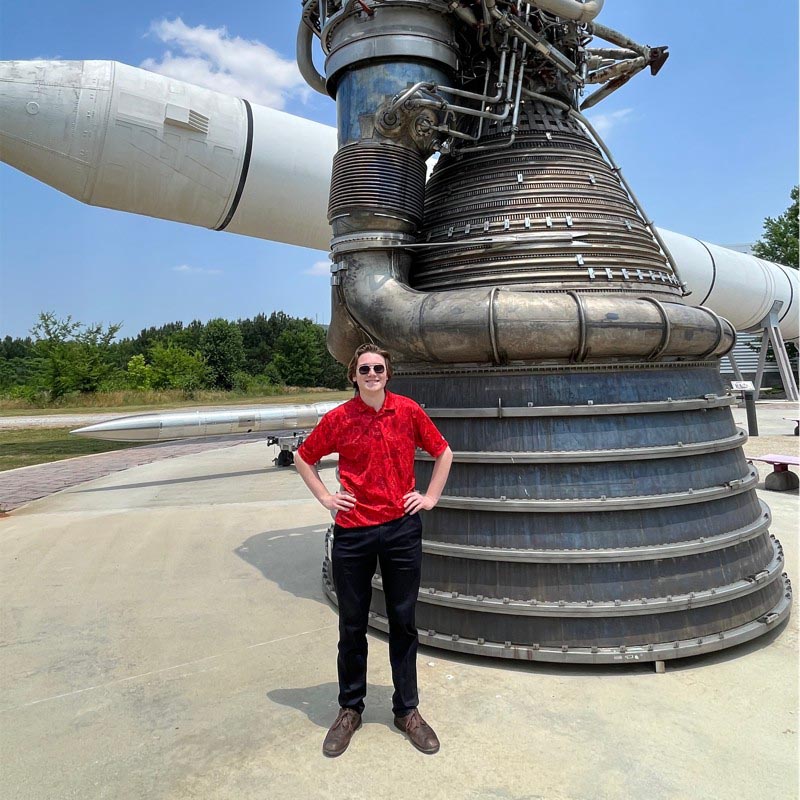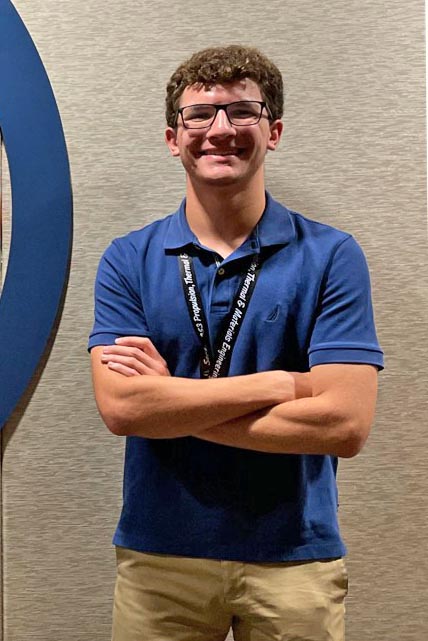Boilermakers receive NASA research fellowships
Four Purdue Engineering students have been chosen to collaborate with NASA on world-changing research, as part of the NASA Space Technology Graduate Research Opportunities (NSTGRO).
Since 2011, NASA’s Space Technology Mission Directorate has sponsored the research of graduate students who show significant potential to contribute to NASA’s goal of creating innovative new space technologies for the nation's science, exploration and economic future. Four of the 2025 NSTGRO recipients come from Purdue; three of them from Mechanical Engineering.
 John Carter
John Carter
John Carter is a Ph.D. student in Mechanical Engineering, conducting research with Chris Goldenstein. His group is involved with NASA's Dragonfly spacecraft, scheduled to launch in 2028 and visit Saturn's largest moon, Titan. The unique atmosphere on Titan means that Dragonfly's entry, and other similar missions, will create extreme conditions that have been difficult to simulate on Earth. John’s research seeks to address this simulation challenge to aid future missions. "In my fellowship I aim to develop new diagnostics using laser absorption and optical emission spectroscopy, to be implemented in shock tube experiments that recreate that atmospheric entry," Carter said. "We want to better understand the non-equilibrium chemistry of the cyano radical (CN) due to these strong shocks. I also will develop a new chemical kinetic mechanism that accounts for state-dependent reaction kinetics and thermal non-equilibrium of CN produced in Titan's atmosphere."
 Devin Johnson
Devin Johnson
Devin Johnson is a Ph.D. student in Mechanical Engineering, working with Terrence Meyer. Meyer's research group specializes in diagnostics of propulsion systems, especially rotating detonation rocket engines (RDREs). "My proposal aims to develop computational fluid dynamic (CFD) simulations to quantify how a revolving detonation wave impacts fuel injection performance within an RDRE," Johnson said. "This study will follow novel multiphase modeling approaches to capture the liquid-gas interface, evaporation, droplet formation and combustion dynamics within the RDRE environment. To experimentally observe spray response, a transparent combustion chamber will allow lasers to fluoresce the liquid fuel while a set of high-speed cameras capture the spray structure from different angles. Upon experimental validation of these models, efforts will be made to reduce computational complexity and solver time for efficient application towards design optimization of backflow resistive and well mixing injector geometries."
 Joseph Ligresti
Joseph Ligresti
Joseph Ligresti is a graduate student in Aeronautics and Astronautics, studying with Timothee Pourpoint. Pourpoint's specialty is hypergolic rocket fuels, which combust instantly upon contact with each other. Ligresti's project is entitled Effects of Vacuum Conditions on Fuel-Oxidizer Reaction Product (FORP) Reactivity and Long-Term Viability of MON-25/MMH Thrusters. "My research plans to characterize the effects of extended exposure to vacuum and thermal gradient conditions on the reactivity of combustion intermediates for low-temperature storable propellants," Ligresti said. "This work will be applied in the context of long cruise phases for exploration missions to the outer Solar System." He will conduct his research at Zucrow Labs, the largest academic propulsion lab in the world.
 Andrew Witty
Andrew Witty
Andrew Witty is a Master's student in Mechanical Engineering, studying with Xiulin Ruan. Ruan earned a Guinness World Record for inventing the world's whitest paint, whose nanostructures reflect more than 98% of solar radiation, passively cooling surfaces below their ambient temperature. Witty wants to apply that groundbreaking thermal protection to spacecraft. "This project aims to advance thermal control coatings for NASA, focusing on developing scalable nanoporous paints with high solar reflectance and durability in harsh space environments," he said. "I will engineer our existing paints and coatings to withstand high UV irradiation, atomic oxygen fluence, thermal cycling, and more. We will then evaluate these coatings in simulated space conditions to assess their durability."
